
The choices of running shoes available in the market can easily confuse a beginner.
So I decided to make a comprehensive guide to running shoes.
This guide will help you:
- Determine your foot type
- Understand how many types of shoes are available in the market
- Learn the most important factors about choosing running shoes
- Learn how your shoes should fit properly
The first step is to determine your foot type. We’ll do so by learning about pronation.
What is Pronation
Pronation is the slight inward movement of our ankle bone when our foot lands on the ground while running or walking.
It is a natural and necessary movement which helps us absorb the shock caused by landing on the ground.
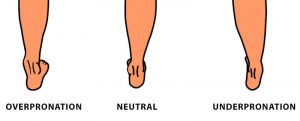
Types of Pronation
Different people’s feet pronate to different degrees meaning some people pronate more and some less. Generally, runners are classified into three following categories according to the degree of pronation:
Neutral Pronation
Neutral or normal pronation is when the foot pronates in a healthy amount. The ankle bone bends inward but not dramatically.
When you pronate normally, more of the toe area is used when pushing off of the ground. The weight distributes evenly throughout the foot making your stride more efficient.
Normal pronation is considered ideal and most people experience this type of pronation.
Overpronation
In overpronation, a runner’s foot rolls inward at a more extreme angle. This makes harder for the foot and ankle to handle the impact of landing.
When you overpronate, you use less of the toe area (almost only big toe or second toe) to push off – making your stride less efficient.
Overpronation can range from mild to severe – flat foot being the most severe type of overpronation.
Underpronation
The third kind of pronation is called underpronation also known as supination. Underpronation is just the opposite of overpronation and it is extremely rare.
An underpronator’s ankle rolls “outward” instead of “inward” upon landing.
The weight of the body is not transferred to the big toe, forcing the outside of the foot and the smaller toes to take the majority of the weight.
Like overpronation, underpronation isn’t ideal either.
Read also: How to Start Running (The ultimate guide to running for beginners)
How to Determine Your Pronation Type at Home?
You can find out about your foot type with these two simple tests that can be done at home:
Test 1: The Wet Foot Test
This test shows you the arch of your foot. The arch is a good indicator of your pronation. Let’s find out how:
You will need:
- Water
- Cardboard or shopping bag

Steps to perform the wet foot test:
- Wet the bottom of your foot. Make sure you wet the whole sole.
- Step on to the cardboard or shopping bag. Put your whole bodyweight as you would while walking or running.
- Step aside. You’ll see one of these footprint types:
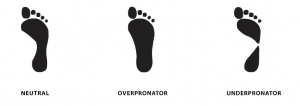
Normal (medium) arch
If your footprint looks something like the first shape in the above picture, you are a normal pronator. This is the most common foot type.
Flat (low) arch
If you can see nearly all of your foot-print (the second shape), that means you have a low arch and there is a good chance of you being an overpronator.
High arch
If you can see just the heel and the ball of your foot like the third shape, you have a very high arch. And chances are, you are an underpronator.
Test 2: The Old Shoe Sole Test
Another test you can perform to know your pronation is – inspect your old pair of running shoes.
A well-worn running shoe can tell a lot about your foot type. Check the wear patterns in the soles to determine what kind of pronation you have.
You’ll see one of the following three patterns:
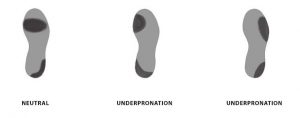
- If you see wear on the ball of your foot and some on the heel, you are neutral pronator.
- If you see wear on the inside of your shoe, its a characteristic of overpronation.
- If you see increased wear on the outer edge of the sole, that means you underpronate.
Types of running shoes
Now you know about your foot type, let’s look at how many types of running shoes are available in the market. And which type will suit you.
There are mainly three types of running shoes, manufacturers make:
1. Neutral/cushioned running shoes
Neutral or cushioned shoes have little to no pronation support. They are designed for runners who have neutral pronation.
These shoes are also best suited for underpronators (supinators) as they encourage normal pronation. They also have plenty of cushioning.
2. Stability Shoes
Stability shoes are designed for people who mildly or moderately overpronate. These shoes have supportive features in the midsole which prevent the foot from overpronating.
Underpronators should avoid these shoes.
3. Motion control shoes
These shoes are best suited for severe overpronators or people with flat feet. They have the maximum amount of supporting features to prevent the overpronation of the foot.
Underpronators should avoid these shoes as well as they will limit the little pronation that exists in these runners which may lead to injuries.
Important Things to Consider
Apart from choosing shoes according to your foot type, here are some important things you should consider before purchasing a pair:
Consider Surface
It’s important to consider what kind of surface you’ll be running on and choose accordingly:
Road running shoes
Road running shoes are designed to cushion and absorb the impact on hard regular surfaces. They have less traction than trail running shoe and are lighter in weight.
Trail running shoes
These shoes are designed for off-road routes which are irregular and have rocks, mud, and other obstacles. Trail running shoes have good traction, support, and cushion for uneven surfaces.
Heel-to-toe-drop
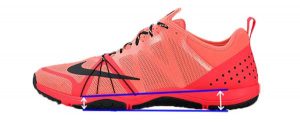
Also called heel drop or offset, it is the difference between the height of the heel and the height of the toe.
The drop is pretty small and is measured in millimetres – it ranges from 0-16mm.
For example, a shoe with 15mm thick heel and 5mm thick forefoot will have a 10mm heel drop. And a shoe with the same heel and forefoot height will be a “zero drop” shoe.
This is an important feature of running shoes that you should consider. It affects how your foot lands on the ground while running.
A low heel drop (0-8mm) encourages midfoot or forefoot strike while a high heel drop (10-12) promotes heel striking.
So if you are a forefoot or mid-foot striker go for low drop running shoes and if your heel first contacts the ground while running, go for higher-drop shoes.
Minimalist vs Maximalist Running Shoes
Minimalist running shoes are designed to feel close to barefoot running while providing some protection for your feet.
Generally, minimalist shoes are categorized in these two categories:
- Barefoot Running Shoes – These shoes have zero heel drop, no arch support, and minimal cushioning. Vibram FiveFingers are a good example of the barefoot running shoe.
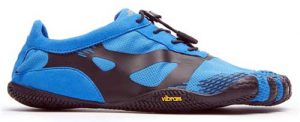
- Minimalist Running Shoes – These are a hybrid of traditional running shoes and barefoot running shoes. They have a heel drop of about 4-8 mm, some cushioning and little to no arch support. Nike Frees are an example of these type of shoes.
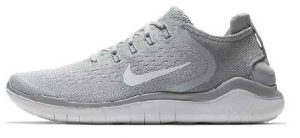
On the other hand, maximalist running shoes have a considerable amount of cushioning and they look bulky. The large amount of cushioning softens the impact of landing on the ground.
These shoes were designed keeping ultrarunners in mind who run extremely long distances. But recently runners have started using these shoes for shorter distances as well.
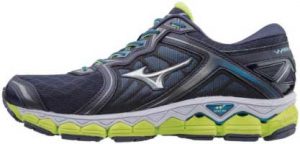
Which one should you choose?
It’s highly subjective – it all comes down to your personal preference. However, if you are going the minimalistic way, make sure you do so gradually. For example, if you have been running in traditional 10-12mm drop shoes and want to try out minimalist shoes, instead of going straight to 0 mm drop or 4mm drop, go with 8mm and see if you like it. You can also experiment with the different amount of cushioning.
Running Shoe Usage
Daily Running Shoes
These are standard running shoes made with good quality materials. They are durable and great choice for long easy runs. As a beginner, you’ll only need these shoes.
Racing Shoes
Racing shoes are lightweight as they have less material than daily running shoes. Advanced runners use these shoes for their speed work and races.
These may not be a good choice for beginners if they want to buy only one pair because these shoes are not as durable as daily running shoes. And they also provide less protection. But when you advance in your training, owning a pair of racing shoes for your speedwork is a good idea.
How running shoes should fit
When it comes to running shoes, comfort and proper fitting are the most important things. Always pay attention to comfort. Here are the things you should do in order to find that perfect pair of running shoes:
- Measure your feet. If it’s been a long time you measured your feet, I’d recommend you measure them again before purchasing a new pair. Best time to do this is towards the end of the day or after a workout as your feet will be at their maximum size due to the activity.
- Go for half or a full size up. One of the most common mistakes new runners make is – running in shoes that are too small for them. I was one of them. Always choose half or even a full size larger than your formal and casual shoes and see the difference for yourself.
- A thumbnail’s gap between your big toe and the end of the shoe. When standing up, make sure there is at least half inch of space between your big toe and the front end of the shoe. You should be able to place a thumb between your big toe and the front end of the shoe. This extra room allows your feet to flex with each stride without a problem.
- Test to see if your shoe is too narrow. Take out the inserts out of your shoes, put on the ground and step on them. If your foot hangs out of the inserts, your shoes are too narrow.
- Firm grip to your heel. Make sure the heel does not slip when you walk or run.
- Wide toe box. You should be able to freely wiggle all your toes inside the shoes. Narrow toe boxes don’t allow the normal spread of the foot bones during running.
- Try on with socks. When trying on shoes, try them with the socks you will be running in. Every little thing matters.
- Measure both your feet. Some people have a slight difference in their feet. If so, fit your shoe on the bigger foot.
- There is no break-in period. The shoes should be comfortable when you try them. It’s not a good idea to assume that the shoes will become comfortable after a few runs. If there is any rubbing or tightness, it can get worse as you run further.
Some shoe manufacturers also make lifestyle shoes, which look like running shoes but they are made for fashion not for running. So you must avoid them at all cost. I’ve seen people buying these shoes from online stores and then leaving a review saying how bad the shoes were for running. I’m sure they bought those shoes because they were from the manufacturers known for making running shoes, such Nike and Adidas. And they just assumed they were made for running.
Please note that finding the right running shoes is an individual process. It’s something you’ll have to discover on your own through trial and error. Use this guide as a starting point.
I hope it has been helpful to you. All the best!
Sources:
- How to select right athletic shoes. aofas.org
- Choosing running shoes. rei.com
- Take the wet test: Learn your foot type. Runner’s World
- Minimalist Shoes. wikipedia.org
You may also like:

